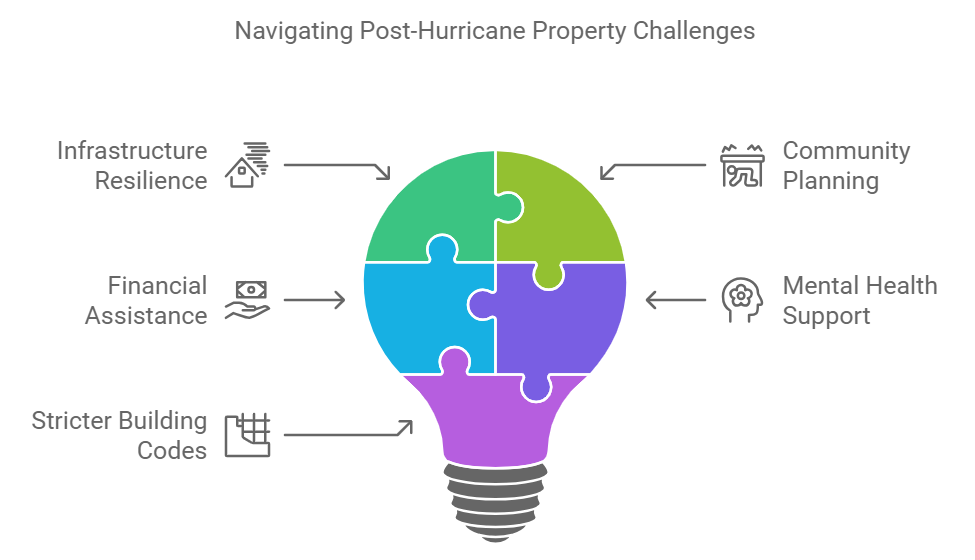The 2024 hurricane season has left a lasting imprint on the southeastern United States, with Hurricanes Helene and Milton causing widespread damage across multiple states. With an estimated $474 million in damages, communities in Florida, North Carolina, and Tennessee face not only the immediate challenges of recovery but also potential long-term impacts on their property values. The significant financial strain from these storms extends beyond infrastructure and home repair costs—it threatens to reshape the future economic landscape, affecting local housing markets, insurance premiums, and real estate investments. This article delves into the financial consequences of Hurricanes Helene and Milton, with a focus on how these events will influence property values in the years to come.

Financial Damage Assessment
The Devastation of Hurricane Helene
Hurricane Helene made landfall as a Category 4 storm, unleashing widespread destruction across coastal and inland communities. Preliminary damage estimates indicate over $474 million in federal disaster assistance is required, with costs continuing to rise as recovery efforts proceed. The financial implications are staggering, especially in states like North Carolina, where over $86 million has already been allocated for housing assistance alone.
Infrastructure and Business Impact
The damage to public infrastructure is extensive, with roads, bridges, and utilities needing significant repair and reconstruction. Businesses have also been severely affected, with many reporting operational interruptions, lost revenues, and, in some cases, permanent closure. The devastation from Helene not only harms individual property owners but also disrupts entire local economies, raising concerns about how quickly affected areas can bounce back.
The Compounding Effect of Hurricane Milton
Coming on the heels of Helene, Hurricane Milton further complicated recovery efforts in the southeastern United States. Although not as powerful as Helene, Milton still caused extensive damage, leaving millions without power and exacerbating the financial burden on local governments. Communities already grappling with Helene’s aftermath were further destabilized by Milton’s impact, resulting in additional cleanup costs and more strain on local infrastructure.
Financial Implications for Local Governments
In both storms’ wake, local governments face an enormous financial burden. They must manage immediate disaster recovery while grappling with long-term fiscal consequences, including decreased property tax revenues and increased borrowing needs to fund cleanup and infrastructure restoration. This combination of reduced income and higher debt levels could lead to budgetary shortfalls in the coming years, forcing municipalities to re-evaluate spending priorities, including those related to public services and future infrastructure investments.
Economic Ripple Effects on Property Values
The immediate and visible damage to homes, businesses, and public infrastructure is just the beginning. The broader economic consequences of these storms are likely to have a profound and long-lasting impact on property values. Regions hit by multiple hurricanes often experience decreased demand in the real estate market, driven by heightened perceptions of risk among potential buyers and rising insurance costs.

Cautious Steps for Future Preparedness
The Importance of Infrastructure Resilience
As communities begin to rebuild from the destruction caused by Hurricanes Helene and Milton, there is a growing consensus on the need to invest in infrastructure resilience. Reinforcing critical infrastructure—such as bridges, roads, and utility systems—can help minimize damage in future storms, but such improvements come with a hefty price tag.
Mitigating Property Value Decline Through Resilient Infrastructure
Investing in resilient infrastructure is one of the key strategies for preventing a significant decline in property values. Real estate located in areas that demonstrate proactive resilience measures—such as hurricane-resistant utilities and elevated flood protections—tends to retain value better than properties in areas that have not invested in such improvements. Investors and homeowners are likely to prioritize communities that show tangible evidence of storm readiness.
Community Disaster Planning as a Property Value Protector
Comprehensive disaster planning plays a critical role in mitigating the impact of hurricanes on property values. Local governments must develop and continually update detailed disaster response plans, which should include evacuation routes, emergency shelters, and communication strategies.
Increasing Buyer Confidence Through Transparent Disaster Plans
Communities that have strong, well-communicated disaster plans are more likely to retain or even increase property values over time, as these plans boost buyer confidence. When potential property buyers know that a community has robust systems in place to handle natural disasters, they are more willing to invest in the area, despite the perceived risk of future storms.
Stricter Building Codes as a Long-term Solution
One of the most effective ways to protect property values in hurricane-prone regions is through stricter building codes. By enforcing higher standards for wind resistance and flood protection, local governments can significantly reduce the damage caused by future hurricanes.
How Stricter Building Codes Influence Insurance and Property Values
Stronger building codes not only protect physical structures but also positively impact insurance premiums and, consequently, property values. Properties built to these higher standards are seen as lower-risk investments by insurers, which can result in lower insurance premiums for homeowners. Lower premiums, combined with the peace of mind offered by hurricane-resistant construction, make these properties more attractive in the real estate market.
Guidelines for Recovery
Conducting Immediate Damage Assessments
Following any major natural disaster, an immediate and thorough damage assessment is critical to ensure that recovery efforts are prioritized effectively. For communities affected by Hurricanes Helene and Milton, this process involves coordination between local authorities and federal agencies such as FEMA.
Impact of Delayed Damage Assessments on Property Values
Delays in conducting these assessments can lead to prolonged uncertainty, which in turn affects real estate transactions. Uncertainty about the true extent of damage may deter potential buyers, leading to a stagnation in the property market. Ensuring timely assessments helps to minimize this uncertainty, allowing the real estate market to stabilize more quickly.
Leveraging Financial Assistance Programs
Accessing federal disaster assistance programs is key to supporting recovery efforts for individuals and businesses affected by the hurricanes. Programs like FEMA’s housing assistance and USDA’s resources for producers help ease the financial burden of recovery.
Financial Aid and Property Market Stabilization
These assistance programs also play a vital role in stabilizing property markets. By providing homeowners with the resources to rebuild, financial aid helps prevent a mass sell-off of damaged properties, which can significantly depress property values in affected areas. A well-supported recovery process ensures that fewer properties fall into disrepair, thus maintaining a baseline level of property value in the community.
Community Engagement and Rebuilding Initiatives
Recovery from large-scale disasters like Hurricanes Helene and Milton requires collaboration among local governments, non-profits, and community organizations. Engaging residents in rebuilding efforts not only accelerates recovery but also strengthens community bonds and fosters resilience.
The Role of Community Collaboration in Property Market Recovery
A strong sense of community can have a positive influence on property values. Homebuyers are drawn to neighborhoods where there is active participation in rebuilding and recovery efforts, as these areas are perceived as more resilient. Moreover, areas with strong community engagement tend to recover more quickly, reducing the time it takes for property values to return to pre-storm levels.
Long-term Recovery Planning
In addition to immediate recovery efforts, communities affected by Hurricanes Helene and Milton must also focus on long-term recovery planning. This involves not only the physical rebuilding of homes and infrastructure but also the economic revitalization of the area.
Long-term Planning to Support Property Value Appreciation
The implementation of a long-term recovery strategy is crucial for ensuring that property values do not remain depressed in the aftermath of the hurricanes. Local governments must focus on fostering business recovery, enhancing public services, and promoting sustainable development practices that can attract future investment. By creating an environment that supports long-term growth, these regions can mitigate the downward pressure on property values caused by the hurricanes.
Mental Health Support and Its Influence on Community Stability
Disasters like Hurricanes Helene and Milton take a toll not only on physical infrastructure but also on the emotional well-being of residents. Mental health support services are essential for helping communities cope with the trauma of the event and fostering a sense of resilience.
How Mental Health Support Influences Property Values
While often overlooked, mental health support can play an indirect role in stabilizing property values. Communities that offer strong mental health resources are seen as more resilient, attracting both residents and investors. In contrast, areas where mental health needs are not adequately addressed may experience higher levels of outmigration, which can lead to a decline in property values over time.
Conclusion
Hurricanes Helene and Milton have left an indelible mark on the southeastern United States, with $474 million in damages highlighting the financial and infrastructural toll of these storms. Beyond the immediate cost of recovery, these events have raised critical questions about the future of property values in affected regions.
Investing in infrastructure resilience, stricter building codes, and community planning can help mitigate the long-term impact of hurricanes on property values, ensuring that communities are better prepared for future storms. Furthermore, leveraging federal financial assistance, fostering community engagement, and providing mental health support are essential steps in the recovery process, helping to stabilize and eventually restore property markets.
The lessons learned from Hurricanes Helene and Milton underscore the importance of proactive measures in disaster preparedness and recovery. By prioritizing these actions, communities can not only rebuild but also protect their property values, laying the foundation for a more resilient future.
Citations:
[5] https://www.farmers.gov/protection-recovery/hurricane
[6] https://disasterphilanthropy.org/disasters/2024-atlantic-hurricane-season/
Latest Posts:
- $474 Million in Damages: How Will Hurricanes Impact Future Property Values?
- Tapping into the $6.94 Billion Neuro-Endocrine Tumor Market: Is This the Next Groundbreaking Investment Opportunity?
- Future Market Value: $7.8 Billion by 2030 | Is the Surgical Sutures Market Set for Explosive Growth?
- The Promising Future of the Global Two-Wheeler Catalytic Converter Market: Trends and Projections for 2024-2028
- $4.5 Billion Potential: Is Insolvency Software Your Next Big Investment?

